Fulvic Acid from Chestnut Forest as an Added Qualities to Spring Water: Isolation and Characterization from Fiuggi Waters
(This article belongs to the Section Environmental Mineralogy and Biogeochemistry)
Abstract
1. Introduction
2. Materials and Methods
2.1. Area of Study, Water, and Soil Sampling
2.2. Soil Sample Preparation and Physical-Chemical Characterization
2.3. Isolation of Fulvic Acid from Soil
2.4. Isolation of Aquatic Fulvic Acids
2.5. Pyrolysis-GC-MS Analysis
2.6. NMR Analysis
2.7. FTIR Analysis
3. Results
3.1. Physico-Chemical Characteristics of Soils
3.2. FTIR
3.3. NMR
3.4. Pyrolysis-GC-MS
4. Discussion
5. Conclusions
Author Contributions
Funding
Data Availability Statement
Acknowledgments
Conflicts of Interest
References
- Leonardi, A.; Masiero, M.; Meier, L. Forests and Water, Valuation and payments for forest ecosystem services. In UNECE/FAO Forestry and Timber Section; United Nations Publication: Geneve, Switzerland, 2018. [Google Scholar]
- Bellver-Domingo, A.; Hernández-Sancho, F.; Molinos-Senante, M. A review of Payment for Ecosystem Services for the economic internalization of environmental externalities: A water perspective. Geoforum 2016, 70, 115–118. [Google Scholar] [CrossRef]
- Neary, D.G.; Ice, G.G.; Jackson, C.R. Linkages between forest soils and water quality and quantity. For. Ecol. Manag. 2009, 258, 2269–2281. [Google Scholar] [CrossRef]
- Prestininzi, A.; Ludovici, G. Ecosystem of the Anticolana Valley. Nephron 1999, 81, 82–92. [Google Scholar] [CrossRef] [PubMed]
- Jenkins, M.; Schaap, B. Forest ecosystem services. Background study prepared for the thirteenth session of the United Nations Forum on Forests. In United Nations Forum on Forests; UN Press: New York, NY, USA, 2018. [Google Scholar]
- Carta dei Suoli del Lazio—Scala 1:250.000—v. 2019. Tutela Risorse e Vigilanza sulle Produzioni di Qualità. Available online: http://dati.lazio.it/catalog/it/dataset/carta-dei-suoli-del-lazio-1-250-000-ed-2019/resource/b27732c7-05cc-4447-8dac-386d1fbcf829 (accessed on 27 July 2019).
- Calace, N.; Petronio, B.M.; de Angelis Curtis, S.; Fraioli, A.; Delfini, M.; D’Ascenzo, G. Chemical analysis of water of the Anticolana Valley: Isolation of humic compounds. Nephron 1999, 81, 93–97. [Google Scholar] [CrossRef] [PubMed]
- Freitas, T.R.; Santos, J.A.; Silva, A.P.; Fraga, H. Influence of Climate Change on Chestnut Trees: A Review. Plants 2021, 10, 1463, Erratum in Plants 2022, 11, 11. [Google Scholar] [CrossRef] [PubMed]
- Regional Council Resolution 158/2016. In Adozione delle Misure di Conservazione finalizzate alla designazione delle zone speciali di conservazione (ZSC) ai sensi della Direttiva 92/43/CEE (Habitat) e del DPR 357/97 e s.m.i.—codice IT 60500; Regione Lazio: Frosinone, Italy.
- Fraioli, A.; De Angelis Curtis, S.; Ricciuti, G.; Serio, A.; D’Ascenzo, G. Effect of water of Anticolana Valley on urinary sediment of renal stone formers. La Clin. Ter. 2001, 152, 347–351. [Google Scholar] [PubMed]
- Di Silverio, F.; Ricciuti, G.P.; D’Angelo, A.R.; Fraioli, A.; Simeoni, G. Stone recurrence after lithotripsy in patients with recurrent idiopathic calcium urolithiasis: Efficacy of treatment with fiuggi water. Eur. Urol. 2000, 37, 145–148. [Google Scholar] [CrossRef] [PubMed]
- Davydova, N.K.; Sergeev, V.N.; Girbul, E. The role of humous acids in acqua di Fiuggi mineral water in degrading stones formed in the urinary tract (Review). Pharm. Chem. J. 2014, 48, 587–592. [Google Scholar] [CrossRef]
- MacCarthy, P. The principles of humic substances. Soil Sci. 2001, 166, 738–751. [Google Scholar] [CrossRef]
- Rashad, M.; Hafez, M.; Popov, A.I. Humic substances composition and properties as an environmentally sustainable system: A review and way forward to soil conservation. J. Plant Nutr. 2022, 45, 1072–1122. [Google Scholar] [CrossRef]
- Simpson, A.J.; Kingery, W.L.; Hayes, M.H.B.; Spraul, M.; Humpfer, E.; Dvortsak, P.; Kerssebaum, R.; Godejohann, M.; Hofmann, M. Molecular structures and associations of humic substances in the terrestrial environment. Naturwissenschaften 2002, 89, 84–88. [Google Scholar] [CrossRef] [PubMed]
- Guimarães, D.V.; Gonzaga, M.I.S.; da Silva, T.O.; da Silva, T.L.; Dias, N.D.S.; Matias, M.I.S. Soil organic matter pools and carbon fractions in soil under different land uses. Soil Tillage Res. 2013, 126, 177–182. [Google Scholar] [CrossRef]
- Sutton, R.; Sposito, G. Molecular structure in soil humic substances: The New View. Environ. Sci. Technol. 2005, 39, 9009–9015. [Google Scholar] [CrossRef] [PubMed]
- Pettit, R.E. Organic matter, humus, humate, humic acid, fulvic acid and humin: Their importance in soil fertility and plant health. CTI Res. 2004, 10, 1–7. [Google Scholar]
- Orlov, D.S. Humic Substances of Soils and General Theory of Humification; Taylor & Francis: London, UK, 1995. [Google Scholar]
- Lodygin, E.D.; Beznosikov, V.A. The molecular structure and elemental composition of humic substances from Albeluvisols. Chem. Ecol. 2010, 26, 87–95. [Google Scholar] [CrossRef]
- Lehmann, J.; Kleber, M. The contentious nature of soil organic matter. Nature 2015, 528, 60–68. [Google Scholar] [CrossRef] [PubMed]
- Gerzabek, M.H.; Aquino AJ, A.; Balboa YI, E.; Galicia-Andrés, E.; Grančič, P.; Oostenbrink, C.; Tunega, D. A contribution of molecular modeling to supramolecular structures in soil organic matter#. J. Plant Nutr. Soil Sci. 2020, 185, 44–59. [Google Scholar]
- Piccolo, A.; Nardi, S.; Cancheri, G. Macromolecular changes of soil humic substances induced by interactions with organic acids. Eur. J. Soil Sci. 1996, 47, 319–328. [Google Scholar] [CrossRef]
- Piccolo, A.; Nardi, S.; Cancheri, G. Micelle like conformation of humic substances as revealed by size-exclusion chromatography. Chemosphere 1996, 33, 595–600. [Google Scholar] [CrossRef]
- Piccolo, A. The supramolcular structure of humic substances. Soil Sci. 2001, 166, 810–832. [Google Scholar] [CrossRef]
- Piccolo, A. The supramolecular structure of humic substances. A novel understanding of humus chemistry and implications in soil science. Adv. Agron. 2002, 75, 57–134. [Google Scholar]
- Ukalska-Jaruga, A.; Debaene, G.; Smreczak, B. Particle and structure characterization of fulvic acids from agricultural soils. J. Soils Sediments 2018, 18, 2833–2843. [Google Scholar] [CrossRef]
- Thurman, E.M. Isolation, Characterization, and Geochemical Significance of Humic Substances from Ground Waters. Ph.D. Thesis, University of Colorado, Boulder, CO, USA, 1979. [Google Scholar]
- Albertini, M.C.; Dachà, M.; Teodori, L.; Conti, M.E. Drinking mineral waters: Biochemical effects and health implications - The state-of-the-art. Int. J. Environ. Health 2007, 1, 153–169. [Google Scholar] [CrossRef]
- Marabottini, R.; Stazi, S.R.; Papp, R.; Grego, S.; Moscatelli, M.C. Mobility and distribution of arsenic in contaminated mine soils and its effects on the microbial pool. Ecotoxicol. Environ. Saf. 2013, 96, 147–153. [Google Scholar] [CrossRef] [PubMed]
- Stazi, S.R.; IMancinelli, R.; Marabottini, R.; Allevato, E.; Radicetti, E.; Campiglia, E.; Marinari, S. Influence of organic management on As bioavailability: Soil quality and tomato As uptake. Chemosphere 2018, 211, 352–359. [Google Scholar] [CrossRef] [PubMed]
- Gillman, G.P. A proposed method for the measurement of exchange properties of highly weathered soils. Aust. J. Soil Res. 1979, 17, 129–139. [Google Scholar] [CrossRef]
- Loeppert, R.H.; Suarez, D.L. Carbonate and Gypsum. In Methods of Soil Analysis; Sparks, D., Page, A., Helmke, P., Loeppert, R., Soltanpour, P.N., Tabatabai, M.A., Johnston, C.T., Sumner, M.E., Eds.; Soil Science Society of America Book Series, no. 5; Soil Science Society of America: Madison, WI, USA, 1996. [Google Scholar] [CrossRef]
- Hayes, M.B.H. Extraction of Humic Substances from Soil. In Humic Substances in Soil, Sediment, and Water: Geochemistry, Isolation, and Characterization; Aiken, G.R., McKnight, D.M., Wershaw, R.L., MacCarthy, P., Eds.; Wiley-Interscience: New York, NY, USA, 1985; pp. 329–362. [Google Scholar]
- Swift, R.S. Fractionation of Soil Humic Substances. In Humic Substances in Soil, Sediment and Water; Aiken, G.R., McKnight, D.M., Wershaw, R.L., MacCarthy, P., Eds.; Willey: New York, NY, USA, 1985; pp. 387–408. [Google Scholar]
- Aiken, G.R. Isolation and Concentration Techniques for Aquatic Humic Substances. In Humic Substances in Soil, Sediment and Water: Geochemistry and Isolation; Aiken, G.R., McKnight, D.M., Wershaw, R.L., MacCarthy, P., Eds.; Wiley-Interscience: New York, NY, USA, 1985. [Google Scholar]
- Thurman, E.M.; Malcolm, R.L. Preparative isolation of aquatic humic substances. Environ. Sci. Technol. 1981, 15, 463–466. [Google Scholar] [CrossRef]
- Gigliotti, G.; Macchioni, A.; Zuccaccia, C.; Giusquiani, P.L.; Businelli, D. A spectroscopic study of soil fulvic acid composition after six-year applications of urban waste compost. Agronomie 2003, 23, 719–724. [Google Scholar] [CrossRef][Green Version]
- Stevenson, F.J. Humus Chemistry: Genesis, Composition, and Reactions; John Willey and Sons: New York, NY, USA, 1994. [Google Scholar]
- Moraes, G.M.; Xavier, F.A.S.; Mendonça, E.S.; Araújo Filho, J.A.; Oliveira, T.S. Chemical and structural characterization of soil humic substances under agroforestry and conventional systems. Rev. Bras. Cien. Solo. 2011, 35, 1597–1608. [Google Scholar] [CrossRef]
- Machado, W.; Franchini, J.C.; de Fátima Guimarães, M.; Filho, J.T. Spectroscopic characterization of humic and fulvic acids in soil aggregates, Brazil. Heliyon 2020, 6, e04078. [Google Scholar] [CrossRef] [PubMed]
- Haiber, S.; Herzog, H.; Burba, P.; Gosciniak, B.; Lambert, J. Two-dimensional NMR studies of size fractionated Suwannee River fulvic and humic acid reference. Environ. Sci. Technol. 2001, 35, 4289–4294. [Google Scholar] [CrossRef] [PubMed]
- Albers, C.N.; Hansen, P.E. 13C-NMR chemical shift databases as a quick tool to evaluate structural models of humic substances. Open Magn. Reson. J. 2010, 3, 96–105. [Google Scholar] [CrossRef]
- Wu, M.; Song, M.; Liu, M.; Jiang, C.; Li, Z. Fungicidal activities of soil humic/fulvic acids as related to their chemical structures in greenhouse vegetable fields with cultivation chronosequence. Sci. Rep. 2016, 6, 32858. [Google Scholar] [CrossRef] [PubMed]
- Martín, F.; del Rio, J.C.; González-Vila, F.J.; Verdejo, T. Pyrolysis derivatization of humic substances II: Pyrolysis of soil humic acids in the presence of tetramethylammonium hydroxide. J. Anal. Appl. Pyrolysis 1995, 31, 75–83. [Google Scholar] [CrossRef]
- Martín, F.; González-Vila, F.J.; del Rio, J.C.; Verdejo, T. Pyrolysis derivatization of humic substances 1: Pyrolysis of fulvic acids in the presence of tetramethylammonium hydroxide. J. Anal. Appl. Pyrolysis 1994, 28, 71–80. [Google Scholar] [CrossRef]
- Del Rio, J.C.; Hatcher, P.G. Analysis of aliphatic biopolymers using thermochemolysis with tetramethylammonium hy-droxide (TMAH) and gas chromatography—Mass spectrometry. Org. Geochem. 1998, 29, 1441–1451. [Google Scholar] [CrossRef]
- Santos Bento, M.F.; Pereira, H.; Cunha, M.Á.; Moutinho, A.M.C.; van den Berg, K.J.; Boon, J.J. A study of variability of suberin composition in cork from Quercus suber L. using thermally assisted transmethylation GC—MS. J. Anal. Appl. Pyrolysis 2001, 57, 45–55. [Google Scholar] [CrossRef]
- Nierop, K.G.J. Origin of aliphatic compounds in a forest soil. Org. Geochem. 1998, 29, 1009–1016. [Google Scholar] [CrossRef]
- Nierop, K.G.J.; Pulleman, M.M.; Marinissen, J.C.Y. Management induced organic matter differentiation in grassland and arable soil: A study using pyrolysis techniques. Soil Biol. Biochem. 2001, 33, 755–764. [Google Scholar] [CrossRef]
- Quénéa, K.; Derenne, S.; Largeau, C.; Rumpel, C.; Mariotti, A. Spectroscopic and pyrolytic features and abundance of the macromolecular refractory fraction in a sandy acid forest soil (Landes de Gascogne, France). Org. Geochem. 2005, 36, 349–362. [Google Scholar] [CrossRef]
- Hatcher, P.G.; Clifford, D.J. Flash pyrolysis and in situ methylation of humic acids from soil. Org. Geochem. 1994, 21, 1081–1092. [Google Scholar] [CrossRef]
- Amir, S.; Hafidi, M.; Lemee, L.; Bailly, J.-R.; Merlina, G.; Kaemmerer, M.; Revel, J.-C.; Amble, A. Structural characterization of fulvic acids, extracted from sewage sludge during composting, by thermochemolysis–gas chromatography–mass spectrometry. J. Anal. Appl. Pyrolysis 2006, 77, 149–158. [Google Scholar] [CrossRef]
- Saiz-Jimenez, C. Origin and Chemical Nature of Soil Organic Matter. Ph.D. Thesis, Delft University Press, Delft, The Nederland, 1988. [Google Scholar]
- Guggenberger, G.; Zech, W. Dissolved organic carbon in forest floor leachates: Simple degradation products or humic substances? Sci. Total Environ. 1994, 152, 37–47. [Google Scholar] [CrossRef]
- Schnitzer, M.; Schulten, H.R. New Ideas on the Chemical Make-up of Soil Humic and Fulvic Acids. In Future Prospects for Soil Chemistry; Soil Science Society of America: Madison, WI, USA, 1998; Volume 55, pp. 153–177. [Google Scholar]
- van Bergen, P.F.; Flannery, M.B.; Poulton, P.R.; Evershed, R.P. Organic Geochemical Studies of Soils from the Rothamsted Classical Experiments. III: Nitrogen-Containing Macromolecular Moieties in Soil Organic Matter from Geescroft Wilderness. In Nitrogen-Containing Macromolecules in the Bio and Geosphere; Stankiewicz, B.A., van Bergen, P.F., Eds.; ACS Symposium Series, 707; Oxford University Press: New York, NY, USA, 1988; pp. 321–338. [Google Scholar]
- Tulloch, A.P. Chemistry of Waxes of Higher Plants. In Chemistry and Biochemistry of Natural Waxes; Chemistry and Biochemistry of Natural Waxes; Kolattukudy, P.E., Ed.; Elsevier: Amsterdam, The Netherlands; New York, NY, USA, 1976; pp. 235–287. [Google Scholar]
- Walton, T.J. Waxes, Cutin and Suberin. In Lipids, Membranes and Aspects of Photobiology; Methods in plant biochemistry; Harwood, J.L., Bowyer, J.R., Eds.; Academic Press: New York, NY, USA, 1990; Volume 4, pp. 105–158. [Google Scholar]
- Kolattukudy, P. Biochemistry and function of cutin and suberin. Can. J. Bot. 1984, 62, 2918–2933. [Google Scholar] [CrossRef]
- González-Vila, F.J.; Lankes, U.; Lüdemann, H.D. Comparison of the information gained by pyrolytic techniques and NMR spectroscopy on the structural features of aquatic humic substances. J. Anal. Appl. Pyrolysis 2001, 58, 349–359. [Google Scholar] [CrossRef]
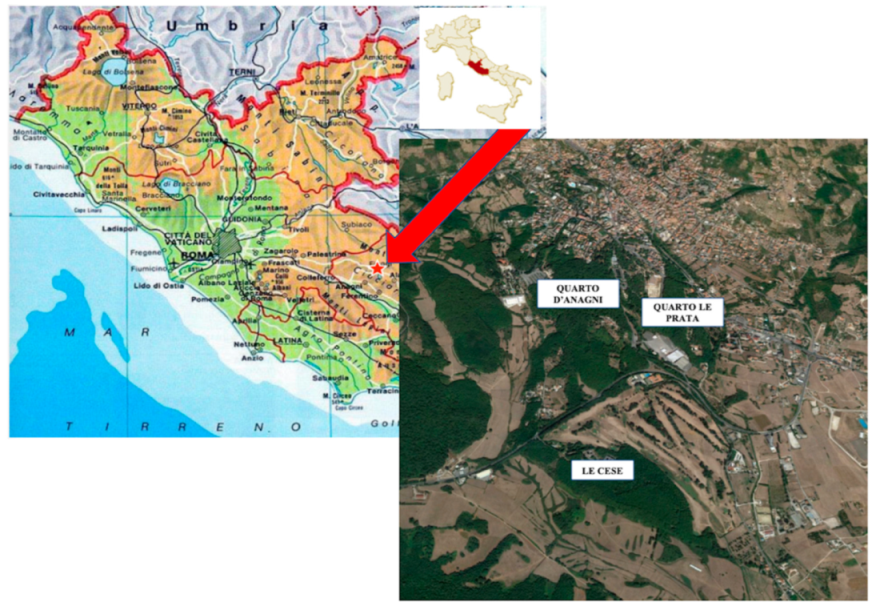
 Quarto d’Anagni;
Quarto d’Anagni;  Le Prata or Lagozzo;
Le Prata or Lagozzo;  Le Cese. (B) Spring of Fiuggi mineral waters.
Le Cese. (B) Spring of Fiuggi mineral waters.
 Quarto d’Anagni;
Quarto d’Anagni;  Le Prata or Lagozzo;
Le Prata or Lagozzo;  Le Cese. (B) Spring of Fiuggi mineral waters.
Le Cese. (B) Spring of Fiuggi mineral waters.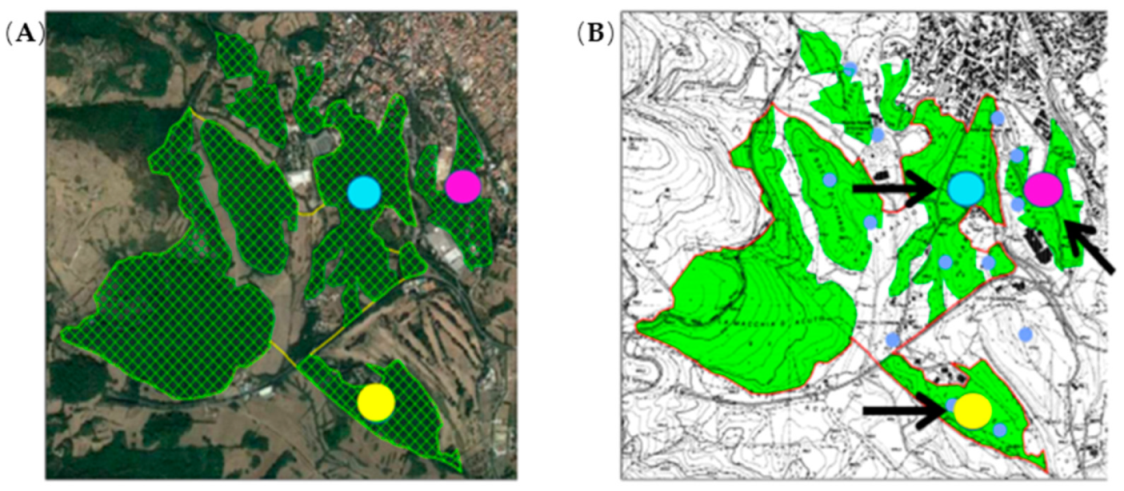
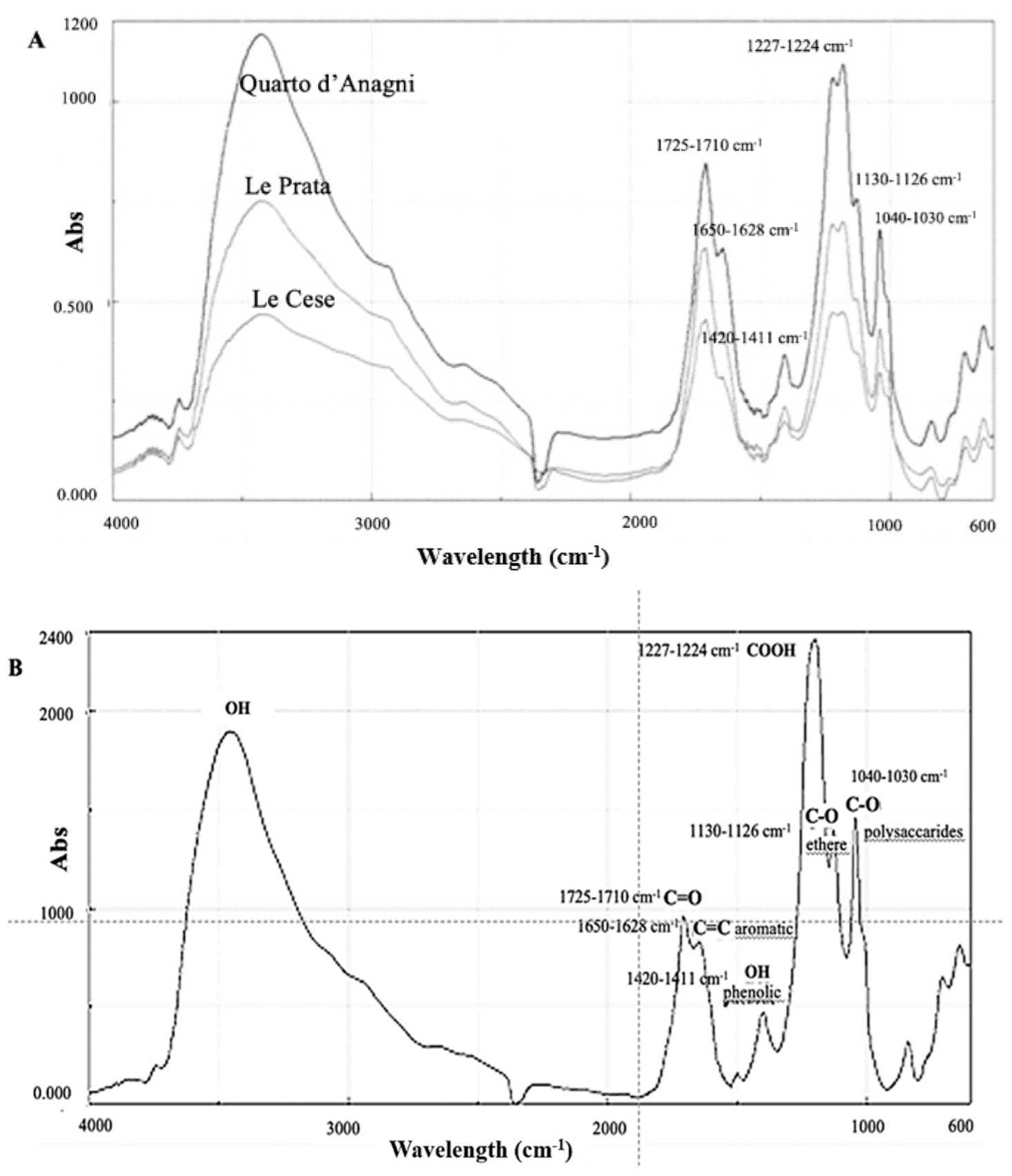
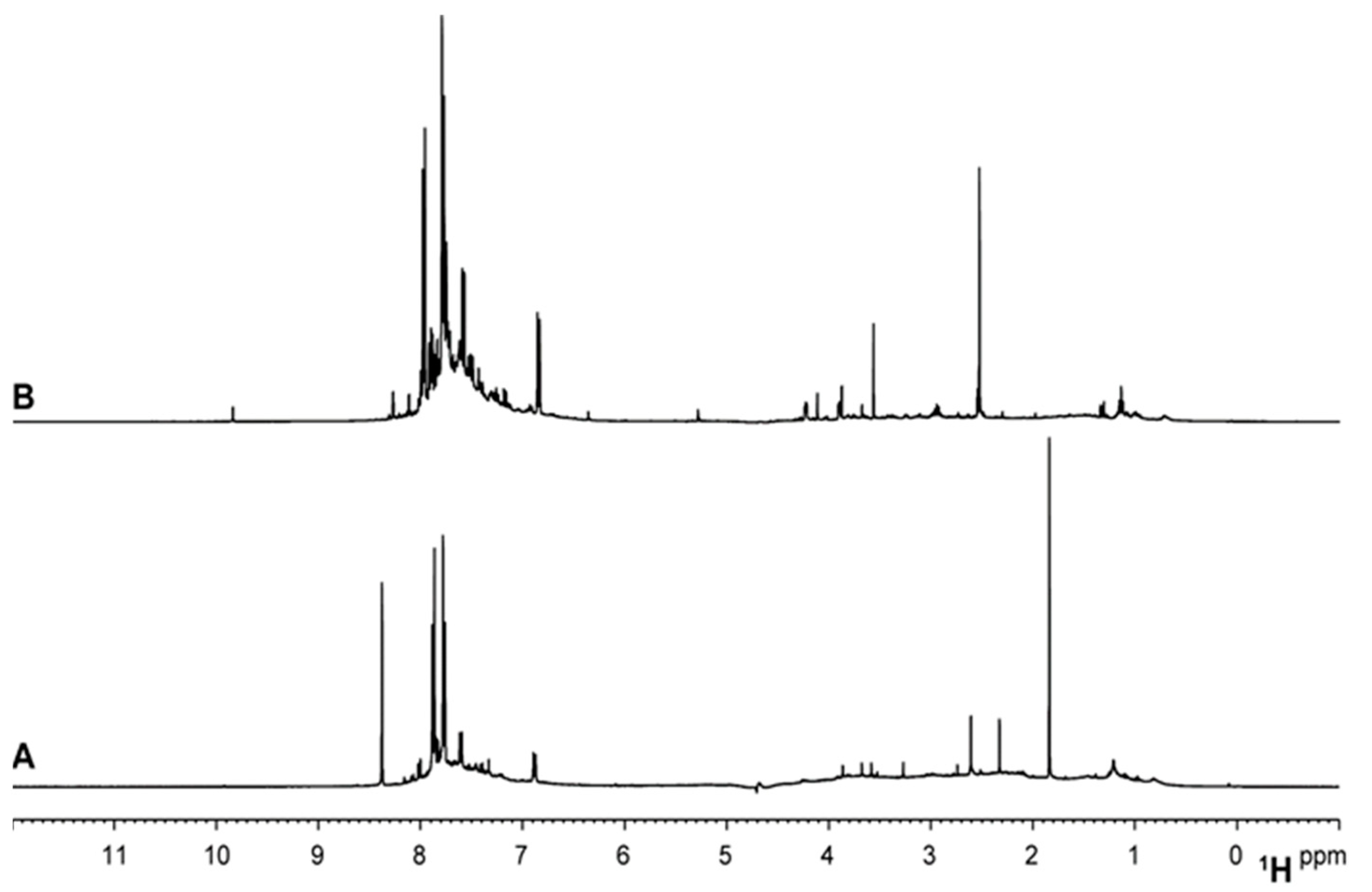

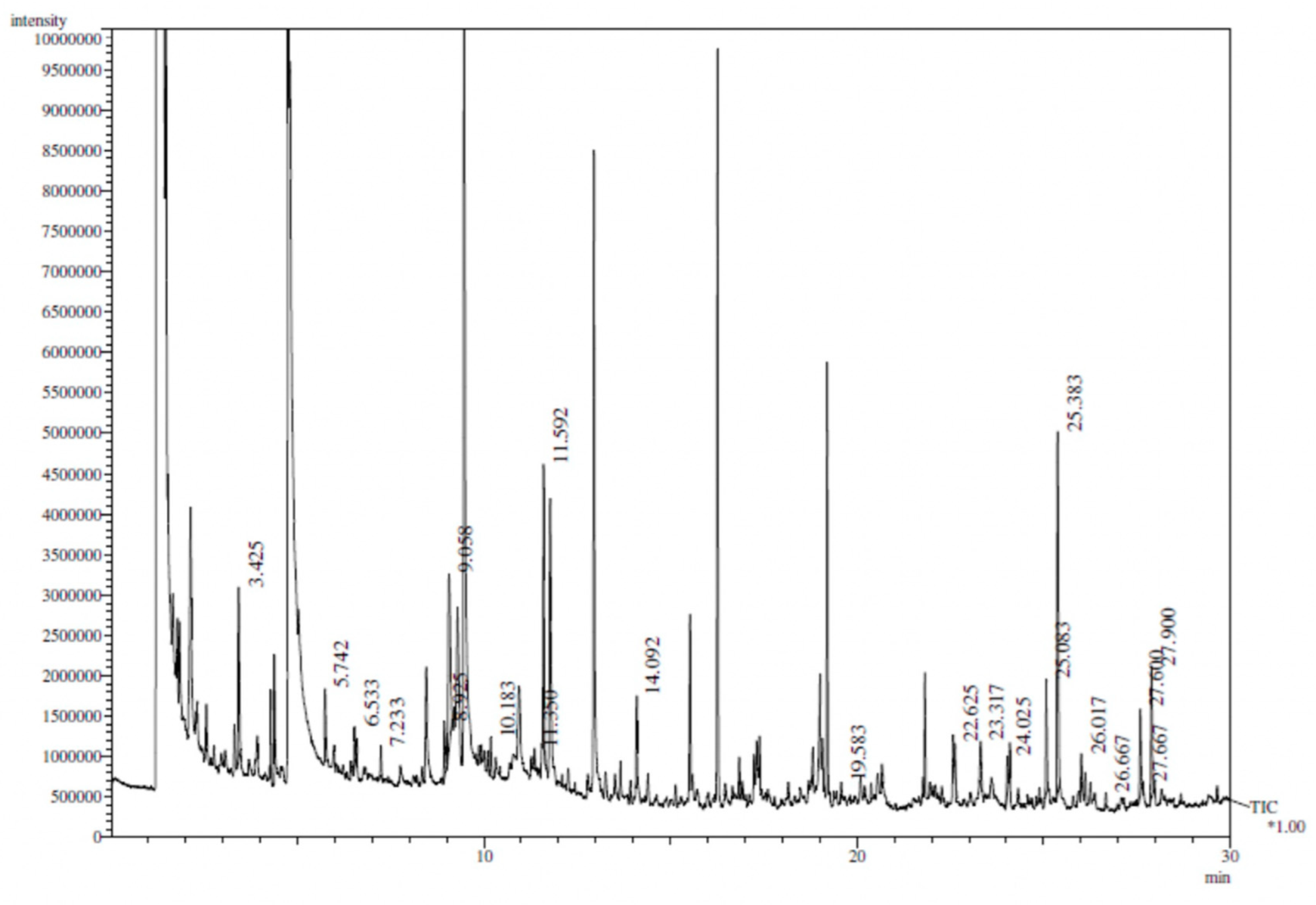
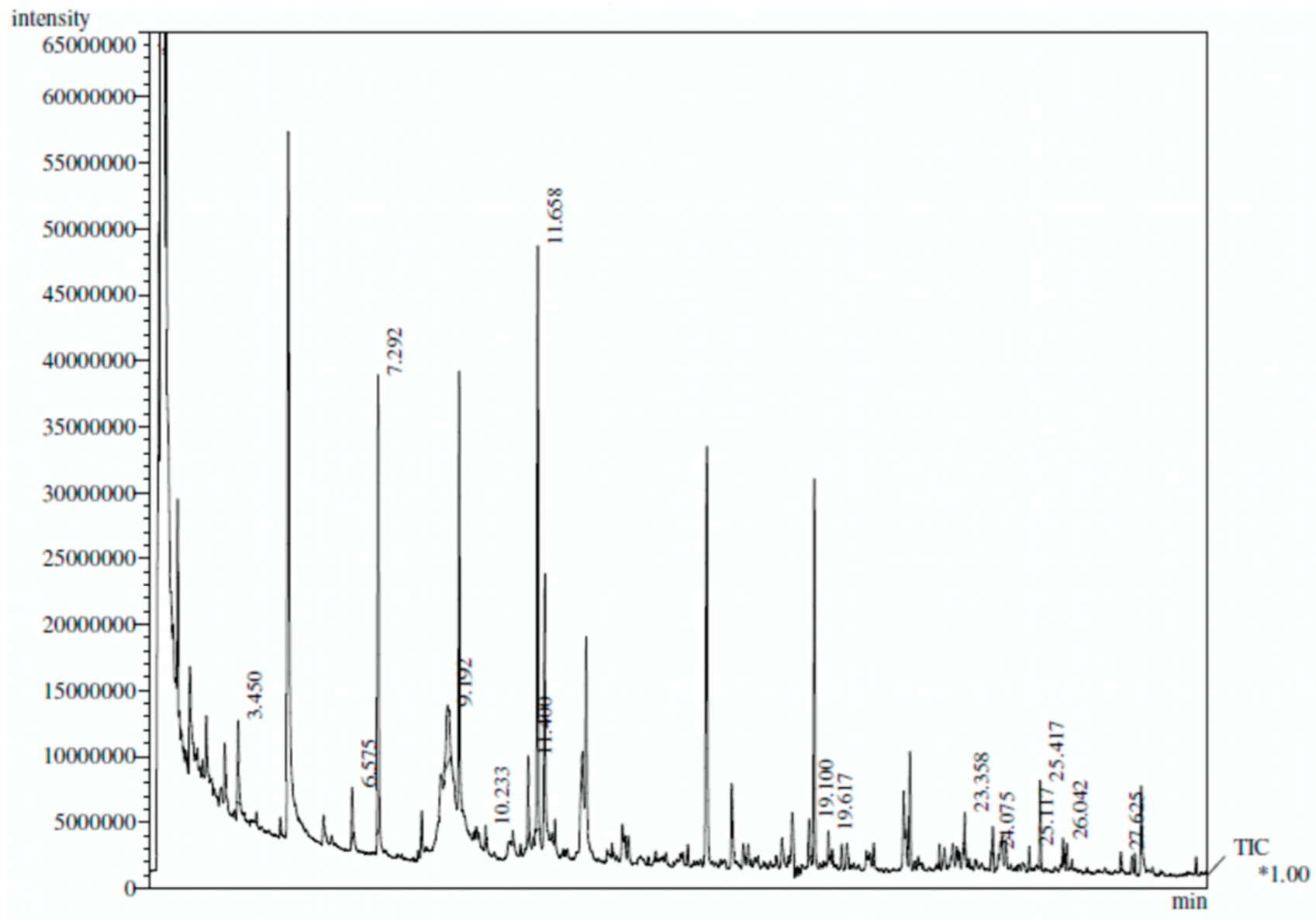
| Parameters | Quarto d’Anagni | Quarto Le Prata | Le Cese |
|---|---|---|---|
| Clay (%) | 28 | 30 | 42 |
| Silt (%) | 40 | 38 | 36 |
| Sand (%) | 32 | 32 | 22 |
| Texture class (USDA) | Clay loam | Clay loam | Clay |
| Electrical conductivity (µs Cm−1) | 858.75 ± 5.047 | 995.00 ± 20.21 | 545.00 ± 55.15 |
| Total limestone (%) | <LD | <LD | <LD |
| pH (H2O) | 5.8 ± 0.3 | 5.2 ± 0.1 | 4.9 ± 0.1 |
| pH (KCl) | 5.4 ± 0.3 | 4.6 ± 0.1 | 4.1 ± 0.1 |
| TOC (g kg−1) | 46.5 ± 0.87 | 39.2 ± 0.26 | 37.2± 0.39 |
| TN (g kg−1) | 3.61 ± 0.36 | 3.02 ± 0.18 | 3.13 ± 0.53 |
| C/N ratio | 12.80 ± 1.14 | 13.00 ± 0.10 | 11.96 ± 0.76 |
| C.E.C. (Cmol(+)kg−1) | 44.69 ± 0.57 | 34.22 ± 0.78 | 39.38 ± 1.31 |
| Soil | FA (g kg−1) |
|---|---|
| Quarto d’Anagni | 5.2 ± 0.02 |
| Quarto le Prata | 6.2 ± 0.04 |
| Le Cese | 5.6 ± 0.04 |
| 0–1.7 ppm | 1.7–3.0 ppm | 3.0–5.0 ppm | 5.0–6.5 ppm | 6.5–9.0 ppm | 9.0–12.0 ppm | |
|---|---|---|---|---|---|---|
| sample | Alkyl-H | Alkyl-H | Carbohydrate-H | Olefin-H | Aromatic-H | Aldehyde-H |
| water | 8 | 10 | 8 | 1.5 | 72 | 0.5 |
| soil | 13.5 | 25 | 18.5 | 3 | 39.5 | 0.5 |
| 0–50 ppm | 50–110 ppm | 110–165 ppm | 165–190 ppm | 190–210 ppm | |
|---|---|---|---|---|---|
| sample | Aliphatic-C | O-Alkyl-C | Aromatic-C | Carboxylic-C | Ketonic-C Aldehydic-C |
| water | 8 | 3 | 84 | 2 | 3 |
| soil | 6 | 4 | 63 | 26 | 1 |
| Retention Time (min) | Name | Class of Compound |
|---|---|---|
| 3.367 | Toluene | aromatic |
| 5.772 | Ethylbenzene | aromatic |
| 6.559 | Styrene | aromatic |
| 7.261 | Benzene, methoxy- | aromatic |
| 8.917 | Hexahydro-1,3,5-Trimethyl-s-triazine | heterocycl |
| 9.101 | Phenol | aromatic |
| 10.111 | 2-Ethyl-4-methylpentanol | alcohol |
| 10.191 | Butanedioic acid, dimethyl ester | dicarboxylic acid |
| 11.358 | Benzene, (methylthio)- | aromatic |
| 11.608 | Benzoic acid, methyl ester | aromatic carboxylic acid |
| 11.809 | Methanethioamide | Thioamide |
| 14.096 | Benzoic acid, 4-methyl-, methyl ester | aromatic carboxylic acid |
| 19.580 | Dodecanoic acid, methyl ester | carboxylic acid |
| 20.690 | Benzoic acid, 3,4-dimethoxy-, methyl ester | aromatic carboxylic acid |
| 22.333 | 10-Undecenoic acid, methyl ester | monounsaturated carboxylic acid |
| 22.628 | Methyl tetradecanoate | carboxylic acid |
| 23.326 | 2-Propenoic acid | carboxylic acid |
| 23.644 | Octadecanoic acid, methyl ester | carboxylic acid |
| 24.040 | Pentadecanoic acid, methyl ester | carboxylic acid |
| 25.088 | 9-Hexadecenoic acid, methyl ester, | carboxylic acid |
| 25.391 | Hexadecanoic acid, methyl ester | carboxylic acid |
| 26.018 | 13-Docosenoic acid, methyl ester | carboxylic acid |
Publisher’s Note: MDPI stays neutral with regard to jurisdictional claims in published maps and institutional affiliations. |
© 2022 by the authors. Licensee MDPI, Basel, Switzerland. This article is an open access article distributed under the terms and conditions of the Creative Commons Attribution (CC BY) license (https://creativecommons.org/licenses/by/4.0/).
Share and Cite
Allevato, E.; Vinciguerra, V.; Stazi, S.R.; Carbone, F.; Zuccaccia, C.; Nano, G.; Marabottini, R. Fulvic Acid from Chestnut Forest as an Added Qualities to Spring Water: Isolation and Characterization from Fiuggi Waters. Minerals 2022, 12, 1019. https://doi.org/10.3390/min12081019
Allevato E, Vinciguerra V, Stazi SR, Carbone F, Zuccaccia C, Nano G, Marabottini R. Fulvic Acid from Chestnut Forest as an Added Qualities to Spring Water: Isolation and Characterization from Fiuggi Waters. Minerals. 2022; 12(8):1019. https://doi.org/10.3390/min12081019
Chicago/Turabian StyleAllevato, Enrica, Vittorio Vinciguerra, Silvia Rita Stazi, Francesco Carbone, Cristiano Zuccaccia, Giuseppe Nano, and Rosita Marabottini. 2022. "Fulvic Acid from Chestnut Forest as an Added Qualities to Spring Water: Isolation and Characterization from Fiuggi Waters" Minerals 12, no. 8: 1019. https://doi.org/10.3390/min12081019
APA StyleAllevato, E., Vinciguerra, V., Stazi, S. R., Carbone, F., Zuccaccia, C., Nano, G., & Marabottini, R. (2022). Fulvic Acid from Chestnut Forest as an Added Qualities to Spring Water: Isolation and Characterization from Fiuggi Waters. Minerals, 12(8), 1019. https://doi.org/10.3390/min12081019






